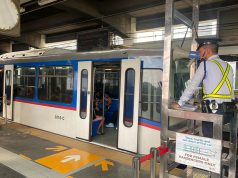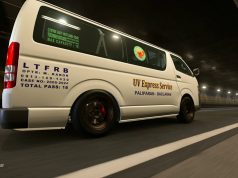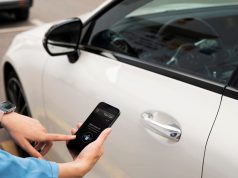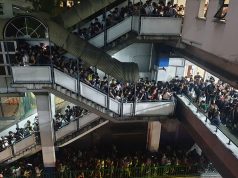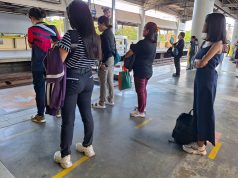
An official of the Metropolitan Manila Development Authority on Tuesday passed the blame of chaos on the roads to commuters who scrambled to get to work during the first day of the general community quarantine in Metro Manila despite the absence of public transport.
During the first three days of the GCQ in Metro Manila, news outlets reported that Filipino workers waited or walked for hours along EDSA, Commonwealth Avenue in Quezon City and other thoroughfares.
Some workers also crowded and fought over police patrol cars, trucks or free buses, which local authorities deployed for them to get to their workplaces. No social distancing measure was observed under these circumstances.
In a radio interview, MMDA General Manager Jose Arturo Garcia claimed that these commuters, citing the ones along Commonwealth Avenue, failed to consider COVID-19 transmission.
“They were focused on traveling even though they [knew], just as the Department of Transportation said, our first priority is health and safety,” Garcia said.
He also expressed disappointment over the commuters’ failure to practice social distancing when boarding the police trucks.
“When they saw the free rides, many commented on social media that commuters fought over these, they were on the road, there were no lines. They were each to his own and forgot that the priority is to stay safe from [the coronavirus],” Garcia said.
Presidential spokesman Harry Roque similarly warned that these areas with residents who continued to violate health protocols such as physical distancing may be reverted to enhanced community quarantine, or the stricter community quarantine measure.
“No place in the Philippines is under ECQ and MECQ. But if many of us do not follow health protocols or do not observe social distancing or physical distancing, wash hands, and continue to leave their homes for unnecessary reasons, we may revert to ECQ or MECQ,” Roque said.
Meanwhile, following the transport chaos during first day of the GCQ last Monday, Transportation Secretary Arthur Tugade admitted that the government did not promise that it will meet the public’s transport needs during the GCQ period, despite their constitutional mandate to do so.
“Wala kaming pinangako o sinabi na ang transportasyon ay magiging extensive and will meet the requirements of all on the first day of GCQ — and even in the duration of the GCQ for that matter. Because as I’ve said, our approach is partial, limited, calculated, and gradual,” Tugade said in an interview with CNN Philippines.
Don’t blame commuters
The remarks of these officials drew criticisms from Filipino social media users, particularly those who also experienced the hardships during their commute under the new directive.
One Twitter user noted that the people behind the deployment of these trucks were the ones who did not enforce social distancing.
“Why is it that it’s always the people’s fault? They NEED to work but you planned poorly for transportation. Then IATF, DOTr or whoever ‘rescues’ them using trucks with NO social distancing whatsoever. Pero pag tumaas ang COVID19 cases, kasalanan nila?!” she said.
A Reddit user criticized the officials and said that they may be detached from the onground situation.

Another Reddit user likewise noted the lack of good implementation and planning for mass transport during the lockdown.

While GCQ rules allowed all modes of mass transportation at limited capacity, the Department of Transportation did not allow jeepneys and UV express vans to ply around the nation’s capital.
The DOTr implemented two phases for public transportation within the month of June. For June 1 to 21, trains, buses, bicycles and shuttle vehicles were given a go signal to operate but only at limited capacity.
Therefore, jeepneys and express vans will only be allowed on June 22.
RELATED: A guide to available modes of mass transport units for areas under GCQ
For Filipino bikers
In a Facebook statement, transport advocacy group Alt Mobility Philippines argued the lack of safe lanes for bicycles which they allowed Filipinos to use for travel.
As we celebrate World Bicycle Day, today, 03 June 2020, we are calling on ALL LOCAL GOVERNMENTS TO CREATE SAFE NETWORKS…
Posted by AltMobility on Tuesday, June 2, 2020
“An urgent need is to provide them with safe corridors for walking and cycling; otherwise, they face a high risk of collision with motor vehicles,” the group’s statement for World Bicycle Day read.
The group appealed to local authorities to pass respective ordinances about establishing proper bike lanes for Filipino bikers.
“To enable local government units to implement these directives expeditiously, we ask that all local government units consider passing an ordinance to establish clear technical guidelines for how the bike lanes will be established and to create the proper institutional structure to implement these initiatives,” it added.
The group, along with other non-profit organizations of Filipino commuters, also provided a bicycle lane ordinance template to serve as a guide for local officials.
Mobility advoacy groups who participated in the collective statement include Bicycle Friendly Philippines, MNL Moves, Kalyestista, and Bayanihan sa Daan.





